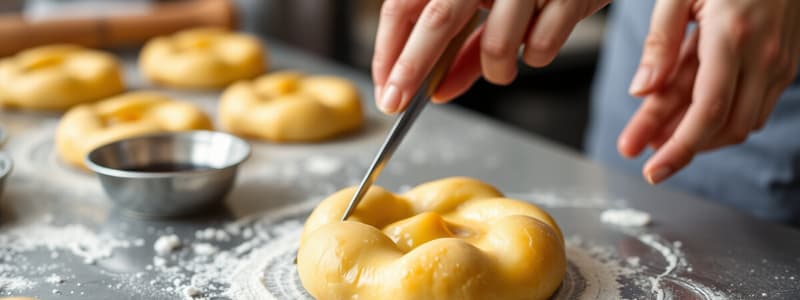Podcast
Questions and Answers
What is a key characteristic that differentiates pastry from bread?
What is a key characteristic that differentiates pastry from bread?
- Pastry uses sugar instead of flour.
- Pastry has a higher fat content. (correct)
- Pastry requires no liquid in the dough.
- Pastry is always sweetened.
What must be avoided when making short crust pastry to prevent toughness?
What must be avoided when making short crust pastry to prevent toughness?
- Over mixing the dough. (correct)
- Incorporating enough liquid early in the process.
- Blending the fat and flour thoroughly.
- Using a rolling pin with too much pressure.
What does the term 'patisserie' refer to in English?
What does the term 'patisserie' refer to in English?
- A specific ingredient used in pastries.
- A method of pastry making.
- A category of sweet baked products. (correct)
- A type of savory pastry.
Which of the following is NOT a common pastry dish?
Which of the following is NOT a common pastry dish?
What technique is used to achieve a flaky texture in Danish pastry and croissants?
What technique is used to achieve a flaky texture in Danish pastry and croissants?
What is the main purpose of rubbing the butter into the flour until breadcrumb consistency?
What is the main purpose of rubbing the butter into the flour until breadcrumb consistency?
What happens if the pastry is over mixed?
What happens if the pastry is over mixed?
Why is it advised to chill the pastry in the fridge before baking?
Why is it advised to chill the pastry in the fridge before baking?
During the pastry-making process, how should water be added?
During the pastry-making process, how should water be added?
What is the role of baking beans when the pastry is pre-baked?
What is the role of baking beans when the pastry is pre-baked?
Flashcards are hidden until you start studying
Study Notes
Overview of Pastry
- Pastry is a dough made from flour, water, and shortening, available in both savory and sweet varieties.
- Sweetened pastries are often referred to as baker's confectionary.
- Common ingredients for pastries include flour, sugar, milk, butter, shortening, baking powder, and eggs.
Types of Pastry
- Small tarts and sweet baked goods are categorized as pastries.
- The French term "patisserie" is used in English to denote similar baked items.
- Typical pastry dishes encompass pies, tarts, quiches, and pasties.
Pastry Dough Characteristics
- Pastry dough is rolled thinly to serve as a base for various baked products.
- Distinguished from bread by a higher fat content, leading to its flaky or crumbly texture.
- Ideal pastry is light, airy, and sufficiently firm to support fillings.
Shortcrust Pastry Preparation
- Proper blending of fat and flour is crucial before adding liquid to minimize gluten development.
- Over mixing can result in tough textures due to long gluten strands.
Flaky Pastry Techniques
- Flakiness in pastries like Danish and croissants is achieved by a method of rolling, buttering, and folding dough to create thin layers.
Basic Steps in Baking Pies and Pastries
- Begin by sieving plain flour and a pinch of salt into a bowl; mix in cold cubed butter until breadcrumb consistency is achieved.
- Gradually add cold water and bring the mixture together, ensuring not to overhydrate, as excess water hampers crispness.
- Roll the prepared pastry on a lightly floured surface to the desired thickness, dusting the rolling pin as needed.
- Transfer the rolled pastry into a tin, ensuring edges overhang for trimming and pricking the base with a fork to prevent bubbling.
Chilling and Baking Process
- Chill the lined pastry in the fridge for 30 minutes to reduce shrinkage during baking.
- Preheat the oven to gas mark 6/200°C (190°C fan oven) before baking for 15-20 minutes or until edges are golden.
- For filled pies, cut a larger circle of pastry for the top, secure edges, trim excess, and create air holes before brushing with beaten egg.
- Bake pies until cooked through and golden.
Additional Notes
- Careful handling and technique are essential for a successful pastry, balancing fat to flour ratio, hydration levels, and baking temperatures.
Studying That Suits You
Use AI to generate personalized quizzes and flashcards to suit your learning preferences.


